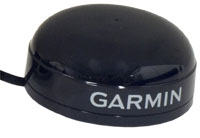GPS16X-HVS GPS Receiver
The GPS16X-HVS GPS receiver is the update to the GPS16-HVS. It consists of a receiver and an integrated antenna. This sensor receives signals from orbiting global positioning system (GPS) satellites, then uses the signals to calculate position and velocity. The GPS16X-HVS can also provide a highly accurate one-pulse-per-second (PPS) output for precise timing measurements.
The GPS16X-HVS sensor is manufactured by Garmin International. Campbell Scientific configures the sensor and modifies its cable. The modified cable terminates in pigtails that attach directly to the control ports of a CR800, CR850, CR1000, or CR3000 datalogger.

Features
Processes data from up to 12 satellites.
Supports real-time WAAS or RTCM corrections for accuracy of 3 to 5 meters.
Allows the datalogger time to be set to the GPS time or local time with the accuracy of the GPS signal.
Provides a timing pulse at 1-sec intervals. The timing pulses are accurate to 1 msec and can be used to sychronize time between the datalogger and other instruments.
Specifications
Receiver: WAAS enabled; 12 parallel channel GPS receiver continuously tracks and uses up to 12 satellites (up to 11 with PPS active) to compute and update the position
Update Rate: Factory set to 1 second between updates; programmable from 1 to 900 seconds
PPS Output: 1 Hz pulse; 1 microsecond accuracy; width factory set to 80 ms
Baud Rate: Factory set to 38400 bps
Operating Voltage: 8 to 40 Vdc
Current Drain: 65 mA active @ 12 Vdc
Position Accuracy (95% typical): <15 m with GPS Standard Positioning Service (SPS); 3 to 5 m with DGPS (USCG/ RTCM) correction; <3 m with DGPS (WAAS) correction
Velocity Accuracy: 0.1 knot RMS steady state
Acquisition Times
Reacquisition: <2 seconds
Hot: ~1 second (all data known)
Warm: ~38 seconds (initial position, time and almanac known, ephemeris unknown)
Cold: ~45 seconds
GPS16X-HVS-PW GPS Receiver
The only difference between the GPS16X-HVS-PW and the GPS16X-HVS is that the cable of the GPS16X-HVS-PW is configured to connect to our prewired enclosures.
The GPS16X-HVS and GPS16X-HVS-PW GPS receivers are the updates to the GPS16-HVS. They consist of a receiver and an integrated antenna. This sensor receives signals from orbiting global positioning system (GPS) satellites, then uses the signals to calculate position and velocity. The GPS16X-HVS-PW can also provide a highly accurate one-pulse-per-second (PPS) output for precise timing measurements.
The GPS16X-HVS-PW sensor is manufactured by Garmin International. Campbell Scientific configures the sensor and modifies its cable. The modified cable terminates in in a connector compatible with our PWENC prewired enclosures, that then attach directly to the control ports of a CR800, CR850, CR1000, or CR3000 datalogger.

Features
Processes data from up to 12 satellites.
Supports real-time WAAS or RTCM corrections for accuracy of 3 to 5 meters.
Allows the datalogger time to be set to the GPS time or local time with the accuracy of the GPS signal.
Provides a timing pulse at 1-sec intervals. The timing pulses are accurate to 1 msec and can be used to sychronize time between the datalogger and other instruments.
Improvements over its predecessor, the GPS16-HVS, include:
Direct connection to the control ports of a CR800, CR850, CR1000, or CR3000 datalogger; an adapter not required
Configured to output data at 38400 bps instead of 1200 bps
Specifications
Receiver: WAAS enabled; 12 parallel channel GPS receiver continuously tracks and uses up to 12 satellites (up to 11 with PPS active) to compute and update the position
Update Rate: Factory set to 1 second between updates; programmable from 1 to 900 seconds
PPS Output: 1 Hz pulse; 1 microsecond accuracy; width factory set to 80 ms
Baud Rate: Factory set to 38400 bps
Operating Voltage: 8 to 40 Vdc
Current Drain: 65 mA active @ 12 Vdc
Position Accuracy (95% typical): <15 m with GPS Standard Positioning Service (SPS); 3 to 5 m with DGPS (USCG/ RTCM) correction; <3 m with DGPS (WAAS) correction
Velocity Accuracy: 0.1 knot RMS steady state
Acquisition Times
Reacquisition: <2 seconds
Hot: ~1 second (all data known)
Warm: ~38 seconds (initial position, time and almanac known, ephemeris unknown)
Cold: ~45 seconds
Producing Area:USA